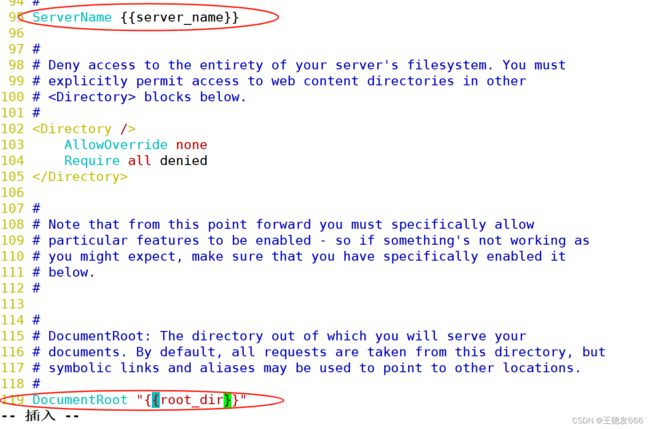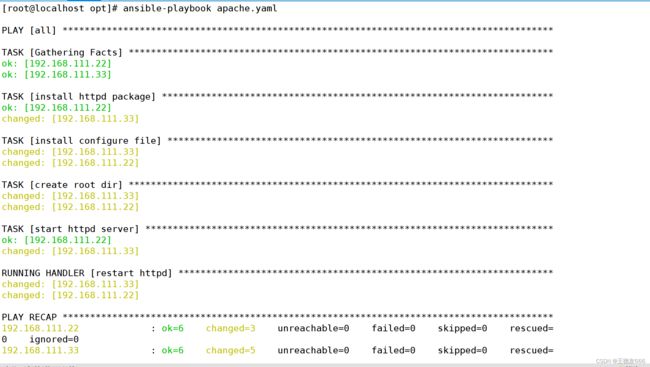ansible的剧本
1 playbook 剧本
1.1 playbooks的组成
Tasks
任务,即通过 task 调用 ansible 的模板将多个操作组织在一个 playbook 中运行
Variables
变量
Templates
模板
Handlers
处理器,当changed状态条件满足时,(notify)触发执行的操作
Roles
角色
1.2 playbooks剧本范例
vim test1.yaml --- #yaml文件以---开头,以表明这是一个yaml文件,可省略 - name: first play #定义一个play的名称,可省略 gather_facts: false #设置不进行facts信息收集,这可以加快执行速度,可省略 hosts: webservers #指定要执行任务的被管理主机组,如多个主机组用冒号分隔 remote_user: root #指定被管理主机上执行任务的用户 tasks: #定义任务列表,任务列表中的各任务按次序逐个在hosts中指定的主机上执行 - name: test connection #自定义任务名称 ping: #使用 module: [options] 格式来定义一个任务 - name: disable selinux command: '/sbin/setenforce 0' #command模块和shell模块无需使用key=value格式 ignore_errors: True #如执行命令的返回值不为0,就会报错,tasks停止,可使用ignore_errors忽略失败的任务 - name: disable firewalld service: name=firewalld state=stopped #使用 module: options 格式来定义任务,option使用key=value格式 - name: install httpd yum: name=httpd state=latest - name: install configuration file for httpd copy: src=/opt/httpd.conf dest=/etc/httpd/conf/httpd.conf #这里需要一个事先准备好的/opt/httpd.conf文件 notify: "restart httpd" #如以上操作后为changed的状态时,会通过notify指定的名称触发对应名称的handlers操作 - name: start httpd service service: enabled=true name=httpd state=started handlers: #handlers中定义的就是任务,此处handlers中的任务使用的是service模块 - name: restart httpd #notify和handlers中任务的名称必须一致 service: name=httpd state=restarted
Ansible在执行完某个任务之后并不会立即去执行对应的handler,而是在当前play中所有普通任务都执行完后再去执行handler,这样的好处是可以多次触发notify,但最后只执行一次对应的handler,从而避免多次重启。
1.3 playbook运行方式
ansible-playbook test1.yaml
| 参数 | 说明 |
|---|---|
| -k(–ask-pass) | 用来交互输入ssh密码 |
| -K(-ask-become-pass) | 用来交互输入sudo密码 |
| -u | 指定用户 |
| --syntax-check | 检查yaml文件的语法是否正确 |
| --list-task | 检查tasks任务 |
| --list-hosts | 检查生效的主机 |
| --start-at-task='install httpd' | 指定从某个task开始运行 |
1.4 playbook模块总结
playbook剧本
vim XXX.yaml XXX.yml
----
- name: 设置play的名称
hosts: 指定执行此play的远程主机组
remote_user: 指定执行此play的用户
gather_facts: 设置是否收集facts信息 yes|no|true|flase
tasks: 指定此play的任务列表
- name: 定义任务的名称
模块名:模块参数 定义任务要使用的模块和参数(键值对格式)
- name:
模块名:模块参数
ignore_errors: true 忽略此任务的失败
- name:
模块名:模块参数
notify: '任务名' 定义此任务执行结果为changed状态时要触发的handlers任务
- name:
模块名:模块参数
when: 定义条件表达式(==、!=、>、>=、<、<=),条件成立时执行此task任务,否则不执行此任务
- name:
模块名:模块参数={{item}}
with_items: 定义循环列表
- name:
模块名:模块参数
tags: 定义任务的标签,ansible-playbook --tags="标签",可实现仅执行拥有指定标签的任务(拥有always标签的任务总是执行)
- 标签1
- 标签2
....
handlers:
- name:任务名
模块名:模块参数
tasks任务的模块语法格式
横向格式:
模块名:参数1=值 参数2={{变量名}} ....
纵向格式:
模块名:
参数1:值
参数2:"{{变量名}}"
....
with_items 和 vars 的语法格式
横向格式:
值为纯量类型时:
with_items:[值1,值2,....]
vars:
变量名:[值1,值2,....]
值为对象类型时(键值对字段)时:
with_items:
- {key1: 值1,key2: 值2}
- {key1: 值3,key2: 值4}
....
纵向格式
-name:
with_items:
- 值1
- 值2
....
vars:
变量名:
- 值1
- 值2
....
tasks:
- name:
模块名: 参数={{item}}
with_items: "{{变量名}}"
值为对象类型时(键值对字段)时:
with_items:
- key1: 值1
key2: 值2
- key1: 值3
key2: 值4
....
vars:
变量名:
- key1: 值1
key2: 值2
- key1: 值3
key2: 值4
....
template配置模版模块
1)先准备一个 XXX.j2 配置模版文件,在模版文件中使用{{变量名}} 格式引用主机变量、组变量、facts信息字段变量或vars字段自定义的变量的值。
2)编辑 playbook 文件,在文件中的 tasks 任务中定义 template 模块配置(template: src=XXX.j2文件路径 dest=远程主机文件路径)
2 playbook剧本内容编写
2.1 定义、引用变量
- name: second play
hosts: dbservers
remote_user: root
vars: #定义变量
- groupname: mysql #格式为 key: value
- username: nginx
tasks:
- name: create group
group: name={{groupname}} system=yes gid=306 #使用 {{key}} 引用变量的值
- name: create user
user: name={{username}} uid=306 group={{groupname}}
- name: copy file
copy: content="{{ansible_default_ipv4}}" dest=/opt/vars.txt #在setup模块中可以获取facts变量信息
2.2 指定远程主机sudo切换用户
必须是被控主机已存在的用户,且ssh密码要与用户密码一致 - hosts: dbservers remote_user: zhangsan become: yes #2.6版本以后的参数,之前是sudo,意思为切换用户运行 become_user: root #指定sudo用户为root 执行playbook时:ansible-playbook test1.yml -k -K 、 需要在客户端添加权限/etc/sudoers
2.3 when条件判断
在Ansible中,提供的唯一一个通用的条件判断是when指令,当when指令的值为true时,则该任务执行,否则不执行该任务。
when一个比较常见的应用场景是实现跳过某个主机不执行任务或者只有满足条件的主机执行任务
hosts: all
remote_user: root
tasks:
- name: shutdown host
command: /sbin/shutdown -r now
when: ansible_default_ipv4.address == "192.168.80.12" #when指令中的变量名不需要手动加上 {{}}
或
when: inventory_hostname == "<主机名>"
ansible-playbook test2.yaml
2.4 迭代
Ansible提供了很多种循环结构,一般都命名为with_items,作用等同于 loop 循环。
vim test3.yaml
---
- name: play1
hosts: dbservers
gather_facts: false
tasks:
- name: create file
file:
path: "{{item}}"
state: touch
with_items: [ /opt/a, /opt/b, /opt/c, /opt/d ]
- name: play2
hosts: dbservers
gather_facts: false
vars:
test:
- /tmp/test1
- /tmp/test2
- /tmp/test3
- /tmp/test4
tasks:
- name: create directories
file:
path: "{{item}}"
state: directory
with_items: "{{test}}"
- name: play3
hosts: dbservers
gather_facts: false
tasks:
- name: add users
user: name={{item.name}} state=present groups={{item.groups}}
with_items:
- name: test1
groups: wheel
- name: test2
groups: root
或
with_items:
- {name: 'test1', groups: 'wheel'}
- {name: 'test2', groups: 'root'}
2.5 tags 模块
可以在一个playbook中为某个或某些任务定义“标签”,在执行此playbook时通过ansible-playbook命令使用--tags选项能实现仅运行指定的tasks。
playbook还提供了一个特殊的tags为always。作用就是当使用always作为tags的task时,无论执行哪一个tags时,定义有always的tags都会执行。
vim webhosts.yaml
---
- hosts: webservers
remote_user: root
tasks:
- name: Copy hosts file
copy: src=/etc/hosts dest=/opt/hosts
tags:
- only #可自定义
- name: touch file
file: path=/opt/testhost state=touch
tags:
- always #表示始终要运行的代码
分别去两台被管理主机上去查看文件创建情况
vim dbhosts.yaml --- - hosts: dbservers remote_user: root tasks: - name: Copy hosts file copy: src=/etc/hosts dest=/opt/hosts tags: - only - name: touch file file: path=/opt/testhost state=touch ansible-playbook dbhosts.yaml --tags="only"
2.6 Templates 模块
Jinja是基于Python的模板引擎。Template类是Jinja的一个重要组件,可以看作是一个编译过的模板文件,用来产生目标文本,传递Python的变量给模板去替换模板中的标记。
1.先准备一个以 .j2 为后缀的 template 模板文件,设置引用的变量
cp /etc/httpd/conf/httpd.conf /opt/httpd.conf.j2
vim /opt/httpd.conf.j2
Listen {{http_port}} #42行,修改
ServerName {{server_name}} #95行,修改
DocumentRoot "{{root_dir}}" #119行,修改
2.修改主机清单文件,使用主机变量定义一个变量名相同,而值不同的变量
vim /etc/ansible/hosts
[webservers]
192.168.80.11 http_port=192.168.80.11:80 server_name=www.accp.com:80 root_dir=/etc/httpd/htdocs
[dbservers]
192.168.80.12 http_port=192.168.80.12:80 server_name=www.benet.com:80 root_dir=/etc/httpd/htdocs
3.编写 playbook
vim apache.yaml
---
- hosts: all
remote_user: root
vars:
- package: httpd
- service: httpd
tasks:
- name: install httpd package
yum: name={{package}} state=latest
- name: install configure file
template: src=/opt/httpd.conf.j2 dest=/etc/httpd/conf/httpd.conf #使用template模板
notify:
- restart httpd
- name: create root dir
file: path=/etc/httpd/htdocs state=directory
- name: start httpd server
service: name={{service}} enabled=true state=started
handlers:
- name: restart httpd
service: name={{service}} state=restarted
ansible-playbook apache.yaml
3 远程部署nginx剧本
3.1 配置playbook配置文件
在本地配置nginx.service vim /lib/systemd/system/nginx.service [Unit] Description=nginx After=network.target [Service] Type=forking PIDFile=/usr/local/nginx/logs/nginx.pid ExecStart=/usr/local/nginx/sbin/nginx ExecReload=/bin/kill -s HUP $MAINPID ExecStop=/bin/kill -s QUIT $MAINPID PrivateTmp=true [Install] WantedBy=multi-user.target 配置playbook文件 vim nginx.yaml - name: third play for install nginx with source gather_facts: false hosts: webservers remote_user: root tasks: #关闭防火墙和selinux - name: disabled firewalld service: name=firewalld state=stopped enabled=no - name: disable selinux command: '/sbin/setenforce 0' ignore_errors: yes - name: disabled selinux forever replace: path=/etc/selinux/config regexp=enforcing replace=disabled after=loaded #安装依赖包 - name: mount cdrom mount: src=/dev/sr0 path=/mnt fstype=iso9660 state=mounted - name: install pkgs yum: name=pcre-devel,zlib-devel,openssl-devel,gcc,gcc-c++,make state=latest #创建运行用户 - name: create nginx user user: name=nginx create_home=no shell=/sbin/nologin #解压软件包并安装 - name: unarchive nginx package unarchive: copy=yes src=/etc/ansible/playbook/nginx-1.24.0.tar.gz dest=/opt/ - name: install nginx with source shell: chdir=/opt/nginx-1.24.0/ ./configure --prefix=/usr/local/nginx --user=nginx --group=nginx --with-http_stub_status_module && make && make install #创建软链接并启动服务 - name: create link file for nginx file: state=link src=/usr/local/nginx/sbin/nginx path=/usr/sbin/nginx - name: create nginx service file copy: src=/lib/systemd/system/nginx.service dest=/lib/systemd/system/nginx.service - name: start nginx service: name=nginx state=started enabled=yes























